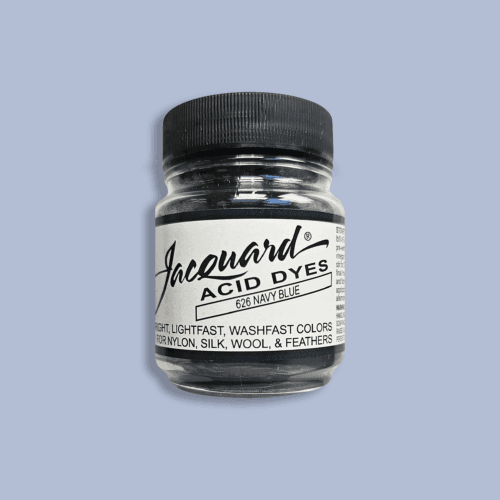Textile paint Acid Dye – Navy Blue
€ 5,95
Jacquard Acid Dye is specially developed for dyeing protein fibers and Nylon.
Despite the name "acid dye," the acids used are mild (such as vinegar or citric acid).
Acid Dye is suitable for Protein fibers and Nylon
Examples: Silk | Wool | Feathers | Cashmere | Alpaca
Acid Dye is not suitable for Cellulose fibers and Synthetic fibers other than Nylon
Examples: Cotton | Linen | Hemp | Polyester | Rayon
2 in stock
Powder dye for Protein fibers
Jacquard Acid Dye is a concentrated, powder dye specifically designed for dyeing protein fibers and nylon.
Despite the name "acid dye," the acids used are mild (such as vinegar or citric acid).
Acid Dye is suitable for Protein fibers and Nylon
Examples: Silk | Wool | Feathers | Cashmere | Alpaca
Acid Dye is not suitable for Cellulose fibers and Synthetic fibers other than Nylon
Examples: Cotton | Linen | Hemp | Polyester | Rayon
Acid dye powder can be used in the washing machine and by the stove-top method. You should use the latter if you are going to dye wool, but it is generally recommended because you achieve the best coloring with it and it requires less dye than if you were to dye with the washing machine.
How much dye do you need?
This depends on the method.
Stove top method: 5-6% per 450 grams of fabric for the colors in the first 2 columns of the table below and up to 8% per 450 grams of fabric for the colors in the last 2 columns.
Washer: As written in the table below per 450 grams of fabric.
Never use more than 8% dye per 450 grams of fabric. Use a lesser amount of dye if you want to achieve a lighter/pastel color.

Read our manual for detailed instructions on dyeing and methods: Acid Dye Manual
Disclaimer
Please note: 3DForma.nl is not responsible for a different color result.
Always test first! After all, dyeing is always an experiment and can unfortunately turn out differently than you would like.
Color
Dye blends with the existing color(s) of the fabric.
If the garment you are dyeing is white or off-white, you should be able to achieve a corresponding color.
If your garment already has a color, your only option is to over-dye it with a darker color, and because the dye will blend with the existing color, a different result must be kept in mind.
Patterns and logos
If the garment you dye has a pattern or logo, the color you use will blend with the existing color(s) in the fabric and create new colors.
Patterns and logos will remain visible even if you dye the fabric in a very dark color.
Coating
The fabric you want to dye may have a coating. You should think about waterproof, stain-resistant, wash-and-wear resistant, permanent press- and wrinkle-resistant finishes.
This cannot be seen with the naked eye and is often not mentioned on labels. If the fabric has a coating, the dye will not pick up (well) and thus the fabric will not color or will color only slightly.
It is recommended to wash a new fabric or garment in warm water and detergent before dyeing. This helps remove any finishes that may interfere with color absorption, but this will not remedy genuine coatings.
Bleaching spots and sun damage
Sun and bleach damage the fabric, making it very difficult to dye. Damaged fibers are not always visible to the naked eye. It is practically impossible to achieve even color when fibers are damaged. The paint is likely to stain.
| Weight | 30 g |
|---|---|
| Dimensions | 6,2 × 5 × 5 cm |
| Brand | Jacquard |
| product kleur | Blue |





